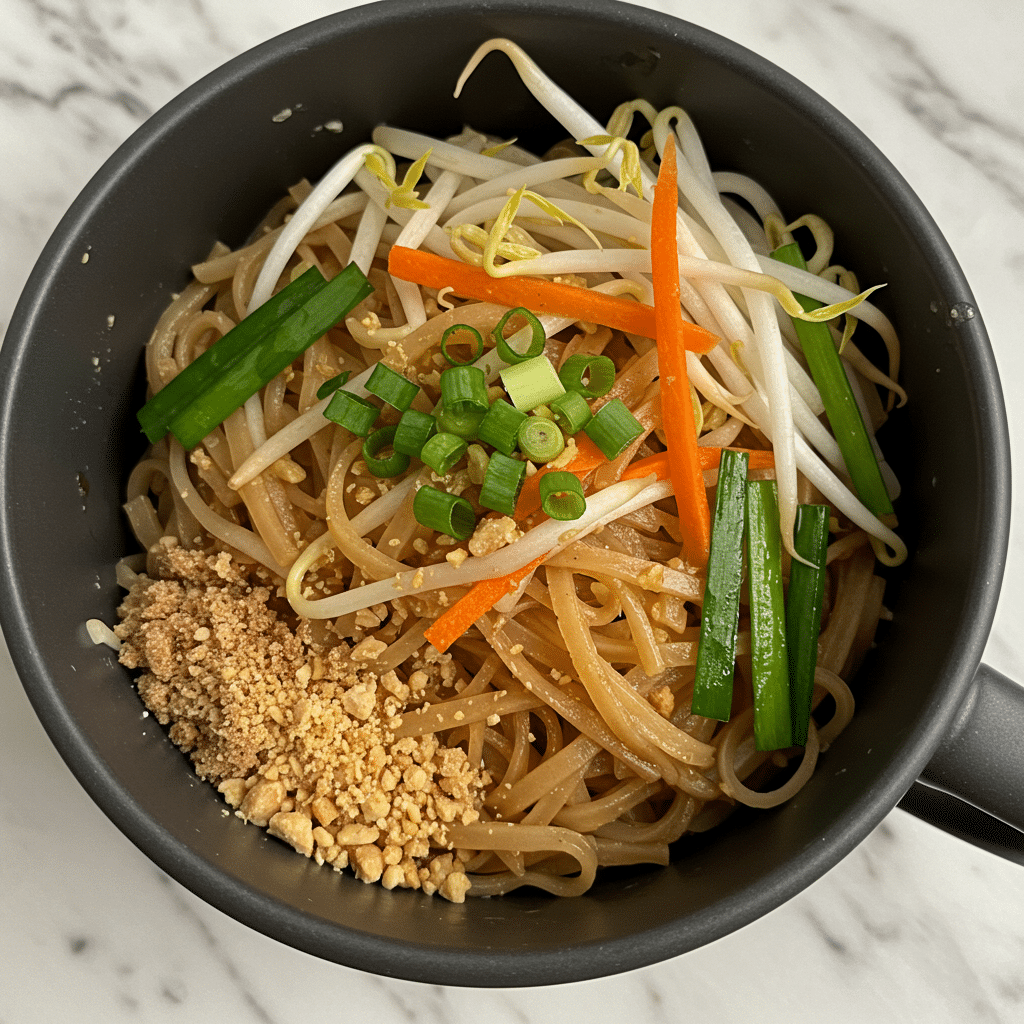Transform your busy weeknight dinners with this incredible Pad Thai in a mug recipe that delivers authentic Thai flavors in just 5 minutes! Whether you’re craving takeout but want something healthier, or you need a quick single serve Pad Thai that won’t leave you with mountains of dishes, this microwave Pad Thai recipe will become your new obsession. We’ll explore everything from the perfect noodle texture to customizing proteins, plus share foolproof techniques for creating restaurant-quality Thai noodle mug meals right in your kitchen.
Table of Contents
Master the Art of Easy Pad Thai in a Mug
Last Tuesday night, I found myself staring into my fridge at 9 PM, exhausted from a long day, with nothing but some rice noodles and a few sad vegetables. My toddler was finally asleep, and I desperately craved something with actual flavor – not another sad sandwich. That’s when inspiration struck: why not try making Pad Thai in a mug? What started as a desperate kitchen experiment turned into my most requested recipe, and honestly, it’s become my go-to solution for those “I need food NOW” moments.
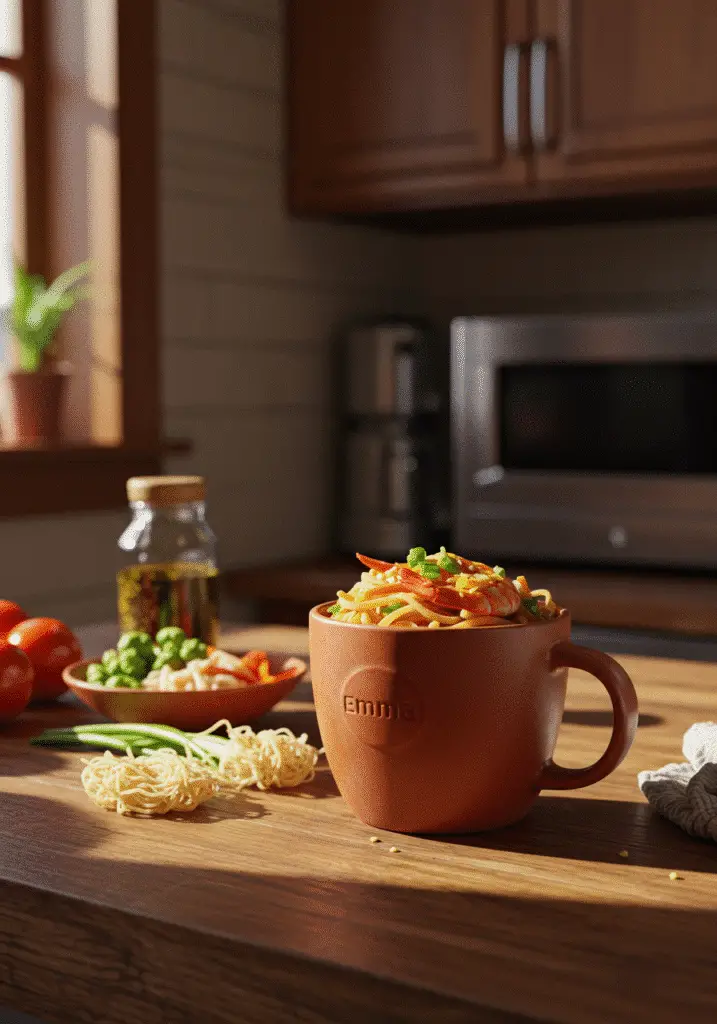
The beauty of this microwave Pad Thai lies in its simplicity and speed. Traditional Pad Thai requires multiple pans, precise timing, and about 30 minutes of active cooking. However, this easy Pad Thai in a mug method streamlines everything into one container, making it perfect for busy weeknights, late-night study sessions, or when you’re cooking for one. The microwave creates the perfect steamy environment that softens noodles while melding all those incredible Thai flavors together.
Why Microwave Pad Thai Actually Works Better
Initially, I was skeptical about making authentic-tasting Thai food in the microwave, but this method actually has some surprising advantages. The contained environment helps the instant Pad Thai noodles mug retain moisture perfectly, preventing that dried-out texture you sometimes get with stovetop versions. Additionally, the gentle, even heating prevents the noodles from becoming mushy while ensuring your vegetables maintain that perfect crisp-tender texture that makes great Pad Thai so satisfying.
For busy people who love the complex flavors of Thai cuisine, this quick Pad Thai recipe opens up a whole new world of possibilities. You can enjoy authentic-tasting Pad Thai during your lunch break, whip up a late-night snack without waking the household, or satisfy sudden cravings without ordering expensive takeout. Plus, making your own means you control the sodium, sugar, and oil content – something that’s nearly impossible with restaurant versions.
Essential Ingredients for Authentic Flavor
Creating restaurant-quality Pad Thai mug recipe starts with understanding the core flavor components that make this dish so addictive. The magic happens when sweet, salty, sour, and umami elements combine perfectly. Fish sauce provides that essential umami depth (though we’ll cover vegan alternatives later), while tamarind paste or lime juice adds the crucial sour note that balances everything out.
Brown sugar or palm sugar creates the signature sweet-savory balance, and a touch of rice vinegar enhances the overall complexity. For proteins, you can easily add cooked shrimp, chicken, or tofu – much like how we customize our protein pancake recipes based on dietary needs. The key is having everything prepped and ready before you start, since this 5-minute Pad Thai recipe moves quickly once you begin.
Perfect Single Serve Pad Thai Techniques
After testing this recipe dozens of times (yes, my family was very patient with me), I’ve discovered that the secret to perfect single serve Pad Thai lies in the layering technique and timing. Unlike traditional cooking methods where you add ingredients in sequence, mug cooking requires a strategic approach that ensures even cooking and flavor distribution. The noodles need direct contact with the liquid for proper hydration, while vegetables should be positioned to steam gently without overcooking.
The microwave power level matters tremendously for this Thai noodle mug meal. I always use 70% power for the first cooking phase, which prevents the noodles from becoming rubbery while ensuring the sauce penetrates every strand. This gentle approach mimics the controlled heat you’d use in a wok, creating that perfect texture balance between tender noodles and crisp vegetables that defines excellent Pad Thai.
Noodle Selection and Preparation
Choosing the right noodles makes all the difference in your Pad Thai microwave noodles success. Rice stick noodles work best because they absorb flavors beautifully while maintaining their texture during microwave cooking. Soak them in warm water for about 10 minutes before cooking – they should be flexible but still firm, similar to how we prep ingredients for our mac and cheese mug recipes.
Thin rice noodles (about 1/8 inch wide) work perfectly for this recipe, though you can experiment with slightly wider versions if that’s what you have on hand. The key is ensuring they’re not completely soft before adding them to your mug – they’ll finish cooking in the microwave and absorb all those incredible flavors. Break longer noodles in half so they fit comfortably in your mug without creating a tangled mess.
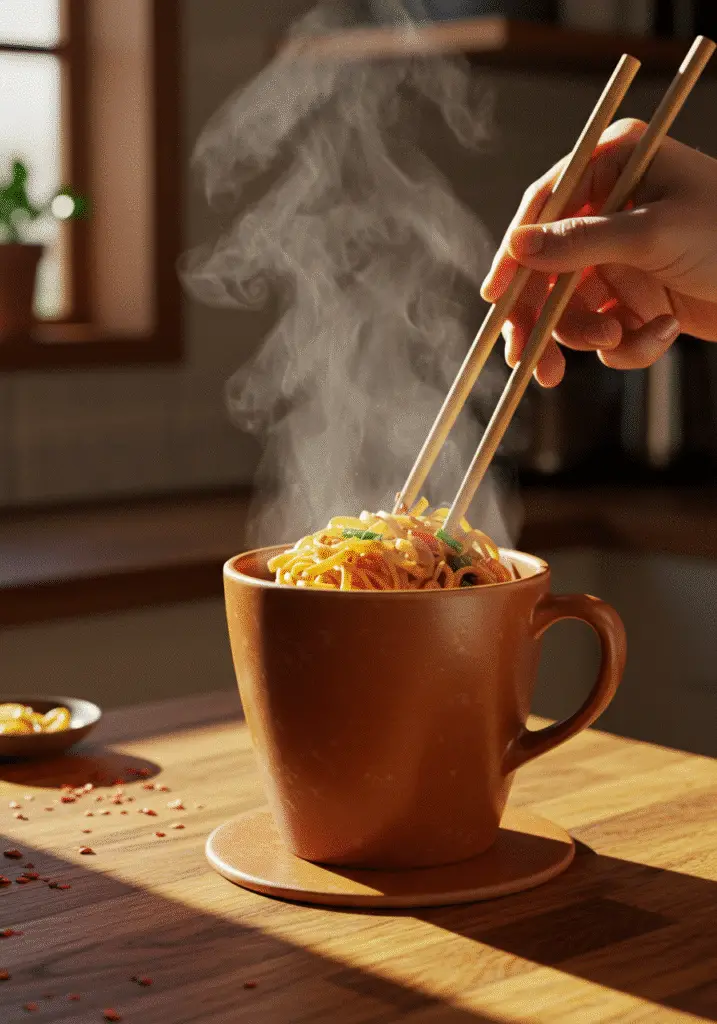
Layering for Optimal Results
Proper layering transforms your instant Pad Thai noodles mug from good to absolutely incredible. Start with your sauce mixture at the bottom – this creates a flavor base that seasons everything above it. Add the pre-soaked noodles next, ensuring they’re mostly submerged in the liquid. Vegetables go on top, where they’ll steam perfectly without becoming mushy.
For proteins like cooked chicken or shrimp, add them in the final minute of cooking to prevent overcooking. This technique works similarly to our cottage cheese mug cake method, where ingredient placement affects the final texture. Fresh herbs and garnishes should always be added after cooking to maintain their bright flavors and vibrant colors.
Customizing Your Vegetarian Pad Thai Mug
One of the most beautiful aspects of this vegetarian Pad Thai mug recipe is its incredible versatility. Whether you’re following a plant-based diet, dealing with food allergies, or simply want to clean out your refrigerator, this recipe adapts beautifully to whatever ingredients you have available. I’ve successfully made versions using everything from leftover roasted vegetables to fresh bean sprouts, and each variation brings its own unique character to the dish.
Creating a satisfying vegan Pad Thai in a mug requires some clever substitutions that don’t compromise on flavor. Instead of fish sauce, I use a combination of soy sauce and mushroom sauce, which provides that essential umami depth. Nutritional yeast adds a subtle cheesy note that enhances the overall complexity, while a tiny splash of seaweed broth (if you have it) contributes oceanic flavors that mimic traditional fish sauce.
Protein Alternatives That Actually Satisfy
The beauty of mug cooking is that you can easily experiment with different protein sources without committing to a full batch. Firm tofu works wonderfully when cubed and added during the last minute of cooking. For a heartier option, try cooked edamame or chickpeas – they add substance and protein while absorbing all those incredible Thai flavors, much like how we enhance our birthday mug cakes with different mix-ins.
Tempeh crumbles create an interesting texture contrast, while cooked lentils make this healthy Pad Thai mug incredibly filling and nutritious. For those who eat eggs, scrambling an egg right in the mug during the final cooking stage creates that authentic Pad Thai experience. The key is adding proteins at the right moment – heartier options can cook with the noodles, while delicate proteins should be stirred in near the end.
Vegetable Combinations That Work
Fresh vegetables transform your peanut Pad Thai mug recipe into a nutritional powerhouse while adding wonderful textures and colors. Bean sprouts provide that signature crunch, while julienned carrots add sweetness and vibrant color. Bell peppers work beautifully, especially red ones that complement the dish’s color palette. Snow peas or snap peas contribute a fresh, crisp element that contrasts perfectly with the soft noodles.
Mushrooms add an earthy depth that enhances the umami elements, while thinly sliced cabbage provides bulk and nutrition. For a spicier version, add thinly sliced jalapeños or a pinch of red pepper flakes. Fresh herbs like cilantro, Thai basil, and mint should always be added after cooking to maintain their bright, fresh flavors. The goal is creating a balance of textures and flavors that makes each bite interesting and satisfying.
Advanced Pad Thai for One Techniques
Once you’ve mastered the basic Pad Thai for one recipe, it’s time to explore advanced techniques that elevate this simple dish into something truly restaurant-worthy. The difference between good and exceptional Pad Thai often lies in the small details: the balance of sweet and sour, the texture of the noodles, and the freshness of the garnishes. These refinements transform your mug Thai noodle recipe from a quick meal into a culinary experience.
Temperature control becomes crucial when perfecting your technique. I’ve discovered that starting with 70% power for the initial cooking, then finishing with a quick burst at full power, creates the ideal texture contrast. This two-stage approach ensures the noodles absorb maximum flavor while preventing overcooking. Additionally, letting the dish rest for 30 seconds after the final cooking stage allows the flavors to settle and meld together beautifully.
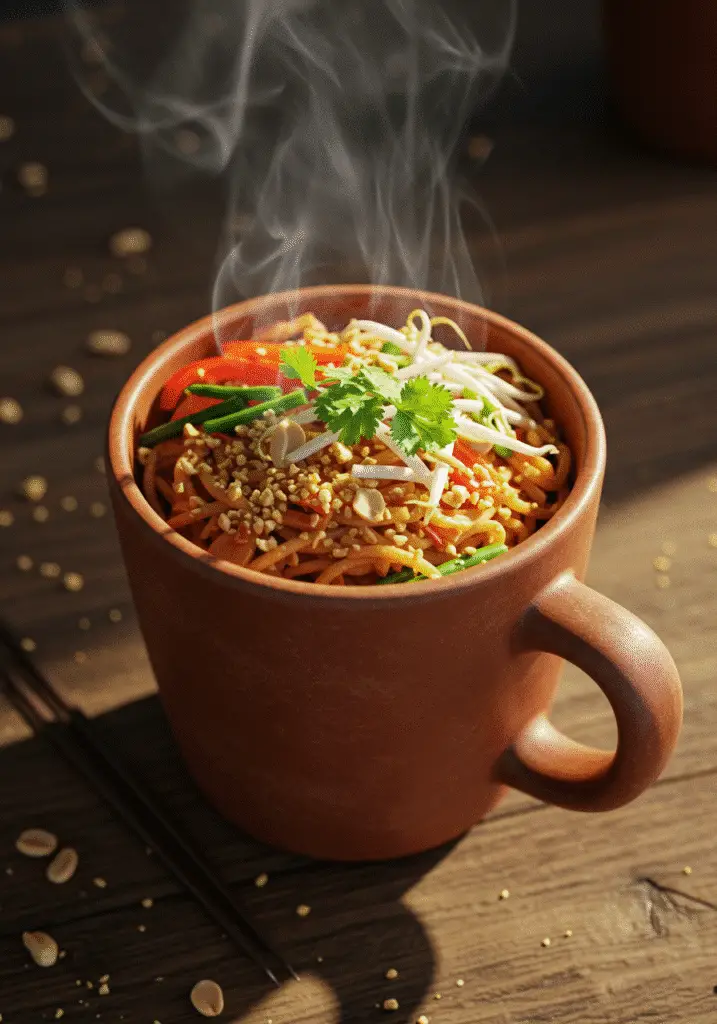
Flavor Balancing Like a Pro
The secret to authentic-tasting easy Asian mug meal lies in understanding the four fundamental flavor elements of Thai cuisine: sweet, sour, salty, and spicy. Start with your base ratios, then adjust to taste. Too sweet? Add more lime juice or tamarind. Too salty? Balance with a touch more brown sugar. Not enough depth? A few drops of fish sauce (or mushroom sauce for vegan versions) work wonders.
Professional Thai cooks taste and adjust constantly throughout the cooking process, and you should too. Before the final microwave stage, give your mixture a quick taste and make any necessary adjustments. This attention to flavor balance separates homemade versions from the often overly sweet or salty restaurant interpretations. Remember, you’re creating a spicy Pad Thai mug recipe that reflects your personal preferences.
Texture Mastery and Timing
Achieving the perfect texture in your low-carb Pad Thai mug (when using shirataki or zucchini noodles) requires understanding how different ingredients respond to microwave cooking. Vegetables should retain some crispness, noodles should be tender but not mushy, and proteins should be heated through without becoming rubbery. This balance comes from strategic timing and proper ingredient preparation.
For consistently perfect results, I recommend keeping a cooking journal, similar to how I track variations in my carrot mug cake experiments. Note cooking times, power levels, and ingredient combinations that work best in your specific microwave. Every microwave cooks slightly differently, so developing your own timing guidelines ensures consistent success every time you make this incredible dish.
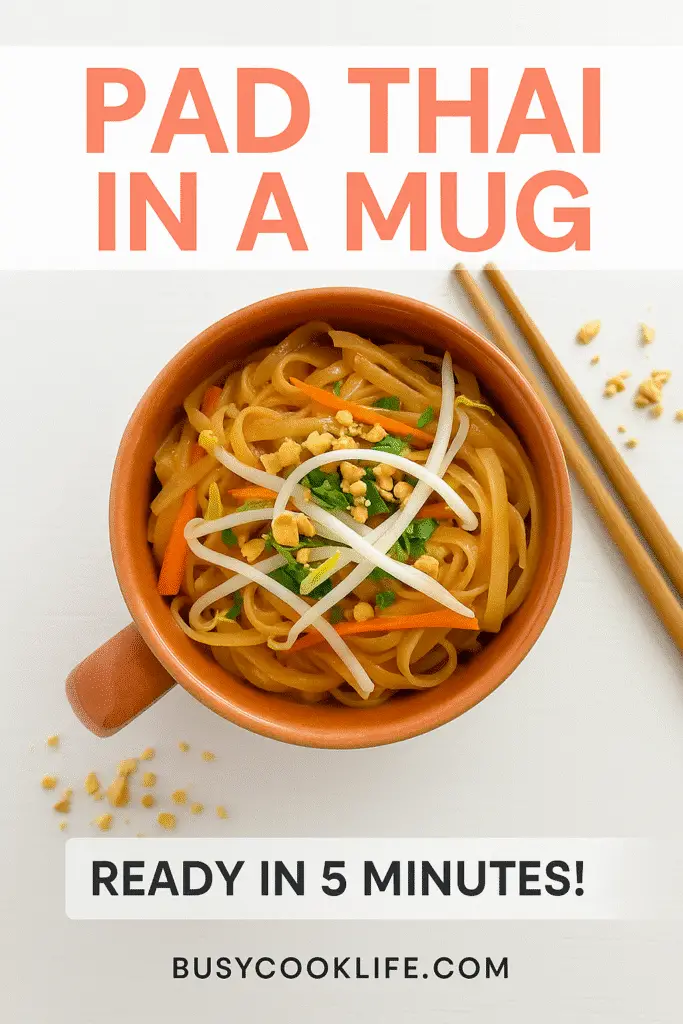
Frequently Asked Questions
Can you make Pad Thai in the microwave?
Yes! Microwave Pad Thai works incredibly well. The contained environment creates perfect steaming conditions that soften noodles while blending flavors beautifully. Use 70% power initially, then finish with full power for best texture.
What ingredients are used in Pad Thai in a mug?
Essential ingredients include rice stick noodles, soy sauce, brown sugar, lime juice, fish sauce (or mushroom sauce for vegan), bean sprouts, carrots, and crushed peanuts. You can customize with your favorite proteins and vegetables.
How long does it take to make Pad Thai in the microwave?
Total time is about 8 minutes: 5 minutes prep (including noodle soaking) and 3 minutes cooking. The microwave method is significantly faster than traditional stovetop Pad Thai which takes 20-30 minutes.
Can you make vegetarian Pad Thai in a mug?
Absolutely! Replace fish sauce with mushroom sauce or extra soy sauce, and add protein-rich ingredients like tofu, edamame, or chickpeas. The vegetarian version is just as flavorful and satisfying as the traditional recipe.
Conclusion
This Pad Thai in a mug recipe proves that incredible Thai flavors don’t require expensive takeout or complicated cooking techniques. In just 8 minutes, you can create a satisfying, restaurant-quality meal that’s perfect for busy weeknights, late-night cravings, or whenever you want something delicious without the cleanup. Whether you stick to the classic version or experiment with vegetarian alternatives, this microwave Pad Thai will become your new go-to comfort food.
The beauty of mug cooking lies in its flexibility and convenience – much like all our favorite quick mug recipes, this dish adapts to your schedule and dietary preferences. From college dorms to busy family kitchens, this easy Pad Thai in a mug brings authentic Thai comfort food within reach of anyone with a microwave and five minutes to spare. So grab your favorite mug, gather your ingredients, and get ready to fall in love with the most convenient Thai food you’ll ever make!
Follow us for more amazing mug recipes: Facebook | Pinterest
Print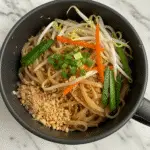
Pad Thai in a Mug: Quick 5-Minute Microwave Thai Noodle Recipe
- Prep Time: 5 minutes
- Cook Time: 3 minutes
- Total Time: 8 minutes
- Yield: 1 serving 1x
- Category: Main Dish
- Method: Microwave
- Cuisine: Thai
Description
Quick and easy Pad Thai made in a microwave-safe mug, ready in just 5 minutes with authentic Thai flavors and customizable ingredients.
Ingredients
1/2 cup rice stick noodles (thin)
2 tablespoons soy sauce
1 tablespoon brown sugar
1 tablespoon lime juice
1 teaspoon fish sauce (or mushroom sauce for vegan)
1/4 cup water
1/4 cup bean sprouts
2 tablespoons julienned carrots
1 green onion, chopped
1 tablespoon crushed peanuts
Optional: cooked protein of choice
Instructions
1. Soak rice noodles in warm water for 10 minutes until flexible
2. In a microwave-safe mug, whisk together soy sauce, brown sugar, lime juice, fish sauce, and water
3. Add drained noodles to the mug, ensuring they’re mostly submerged
4. Top with bean sprouts and carrots
5. Microwave at 70% power for 2 minutes
6. Stir gently, add cooked protein if using
7. Microwave at full power for 1 minute
8. Let rest 30 seconds, then stir and garnish with green onions and peanuts
Notes
For vegan version, replace fish sauce with mushroom sauce or extra soy sauce
Adjust sweetness and acidity to taste
Noodles should be flexible but not completely soft before microwaving
Use 70% power to prevent overcooking
Let rest after cooking to allow flavors to meld
Nutrition
- Serving Size: 1 mug
- Calories: 285
- Sugar: 12g
- Sodium: 1150mg
- Fat: 6g
- Saturated Fat: 1g
- Unsaturated Fat: 5g
- Trans Fat: 0g
- Carbohydrates: 52g
- Fiber: 3g
- Protein: 8g
- Cholesterol: 0mg

